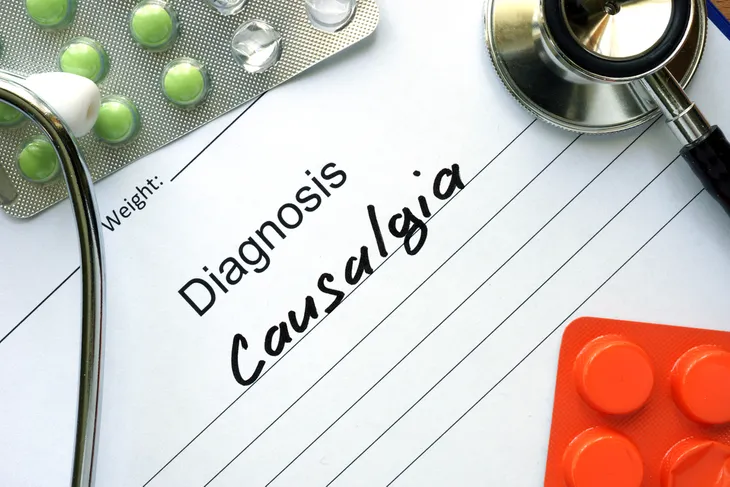Pain is usually fairly black and white – meaning you can trace the cause of it. However, in some cases, it can be more puzzling, such as in the case of complex regional pain syndrome (CRPS), which the Mayo Clinic says is uncommon and not well understood.
This type of pain usually develops following an injury or surgery, and it is “out of proportion to the severity of the initial injury,” explains the source. However, while doctors might not know a lot about it, there are treatments available that are best started early. Read on to learn more about CRPS, including the common symptoms, possible causes, and treatment options.
What Is Complex Regional Pain Syndrome?
According to Medical News Today, this rare and chronic condition often affects one leg, foot, or arm following an injury. The discomfort is disproportionate to the injury. “A person who develops CRPS after experiencing an injury may find that they have pain that is more severe than they would normally have expected with such an injury,” notes the source.
While it often affects just one limb, the source explains there are cases when the entire body is impacted, including the internal organs. It may be an autoimmune condition, in which the body reacts to a perceived threat and causes inflammation. It’s not just pain – there are other associated symptoms that we’ll explain later.
Types of CRPS
As if CRPS wasn’t complex enough, there are actually two types of it, known as type 1 and type 2. They do have similar signs and symptoms, but they have different known causes. Next, we’ll take a closer look into what they are and what causes them.
Understanding Type 1 and Type 2 CRPS
Type 1 is known as reflex sympathetic dystrophy (RSD), which occurs after an illness or injury, and in this case, the pain isn’t from direct damage to nerves in the affected area, according to the Mayo Clinic. It notes about 90-percent of cases fall under this classification.
Furthermore, type 2 was once called “causalgia,” and it shares the same symptoms as type 1. However, in this case, the pain is linked to a nerve injury in the affected area. Mayo Clinic calls it a “distinct nerve injury.”
What Causes CRPS?
There’s still more to be understood about what causes this painful condition. However, WebMD explains that it’s likely “from multiple causes that produce similar symptoms” rather than a single cause.
It says there are theories, such as pain receptors that become sensitive to “nervous system messengers” called catecholamines. Another theory is that an injury could cause an immune response that leads to inflammation of the affected area. “For this reason, it is believed that CRPS may represent a disruption of the healing process,” notes the source.
Symptoms of CRPS
The Cleveland Clinic lists several symptoms that are telltale signs of CRPS with the main one being “pain that is out of proportion to the severity of your injury.” It can get to the point where even a slight touch to the area can be extremely painful.
Other symptoms include a “burning” sensation, swelling of the skin, changes in skin temperature (compared to the opposite limb), discoloration of the affected area (appearing bruised or pale), and decreased range of motion in the affected limb. The onset of these symptoms is usually around 4 to 6-weeks following an injury or surgery.
Symptoms May Spread
It’s worth mentioning that the symptoms of CRPS may get worse over time and may spread from the source to other areas in your body. For example, your opposite limb.
While symptoms of CRPS can go away on their own for some people, others may experience symptoms for months and even years! This is why diagnosing and treating it early is so important.
How Is It Diagnosed?
Unfortunately, there are no specific tests that can pinpoint CRPS. It is diagnosed through a combination of medical history (including whether you’ve had a recent injury or surgery), physical exam, and reviewing your symptoms.
Your healthcare provider will look for signs, such as a difference in temperature between two limbs, the appearance of the skin in the affected area, or an unusual pain response (more specifically, more pain than there should be). They will also look for any other medical conditions that could explain the symptoms.
There Can Be Complications
Prolonged and unexplained pain is likely reason enough to see a doctor. However, the Mayo Clinic explains that if the condition is left unchecked, it can lead to tissue atrophy. That’s when muscle, skin, and bones start to waste away due to immobility.
There’s also the possibility of contractures, which is a medical word for muscle tightening. This can cause your fingers or toes to contract “into a fixed position,” explains the source.
Treatment Options Are Available
While the condition may be poorly understood, doctors have figured out some ways to relieve it. WebMD outlines a number of treatment approaches for CRPS, including sympathetic nerve blocks that involve placing an anesthetic next to the spine.
There’s also a “controversial” surgery called a sympathectomy that destroys the nerves related to CRPS, adds the source.
Other Treatment Options
Other treatment options include intrathecal drug pumps to deliver pain medications into the spinal fluid and spinal cord stimulation using electrodes next to the spine, which apparently offers some patients relief.
In some cases, non-drug strategies such as psychotherapy, can also be helpful.
Can CRPS Be Prevented?
According to the Mayo Clinic, there may be some ways to help ensure CRPS doesn’t develop following an injury. For example, it suggests taking vitamin C following a fracture of the wrist. It cites studies that found those who took a “high dose” of vitamin C following the injury had a lower risk of developing CRPS compared to patients who didn’t. One study suggests 500-mg per day for 7-weeks is a good guideline to follow.
Meanwhile, the clinic also says moving around as much as possible following a stroke may also be helpful. “Some research suggests that people who get out of bed and walk around soon after a stroke (early mobilization) reduce their risk of developing CRPS,” adds the source.
When to See a Doctor
As you can see, early intervention is crucial. If you experience severe pain in a limb, to the point where touching it or moving it is unbearable, then it’s time to book an appointment with your doctor.
At your appointment, explain your symptoms and medical history to help your doctor get to the root cause. Your doctor will then be able to diagnose it and recommend treatment if needed.















